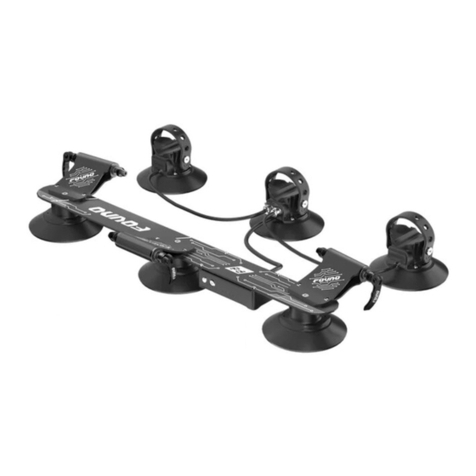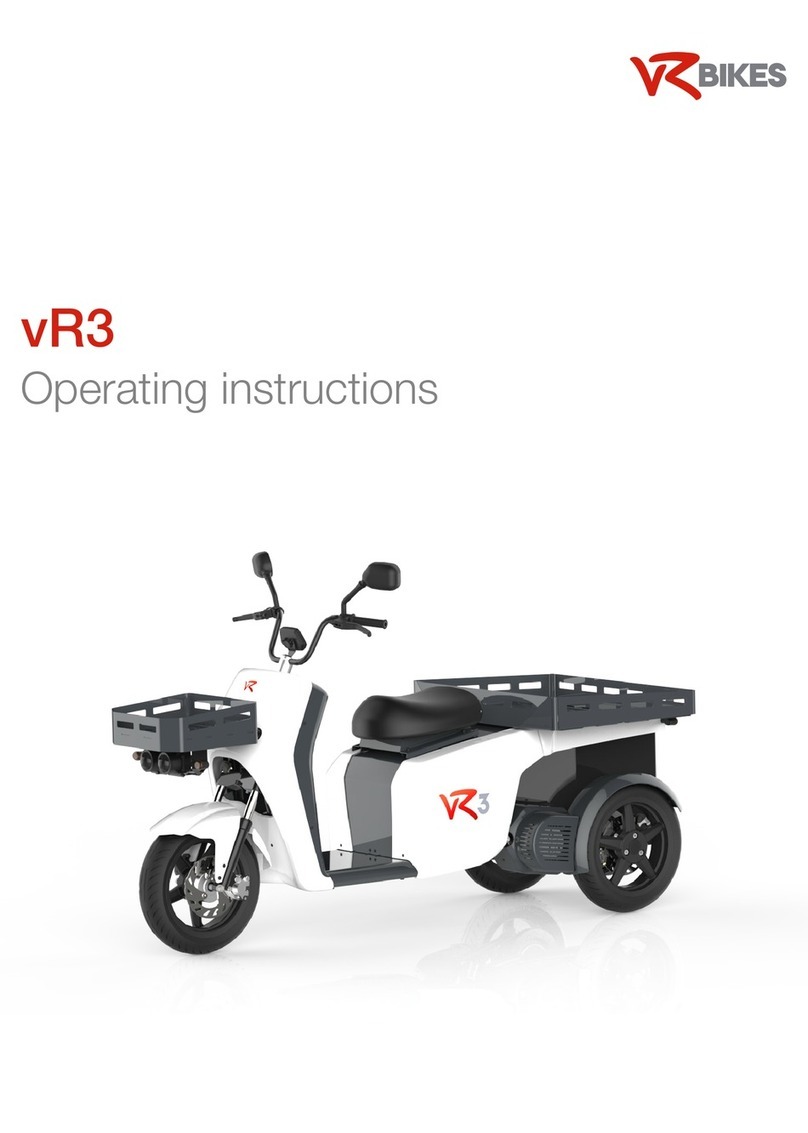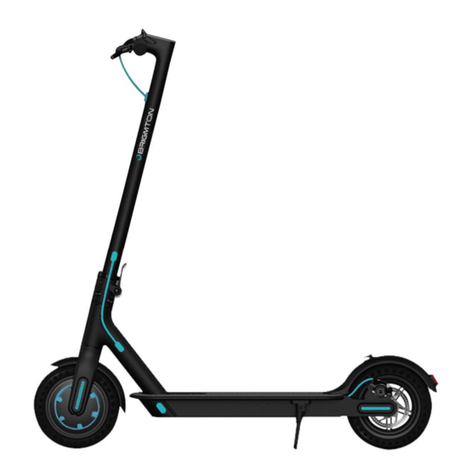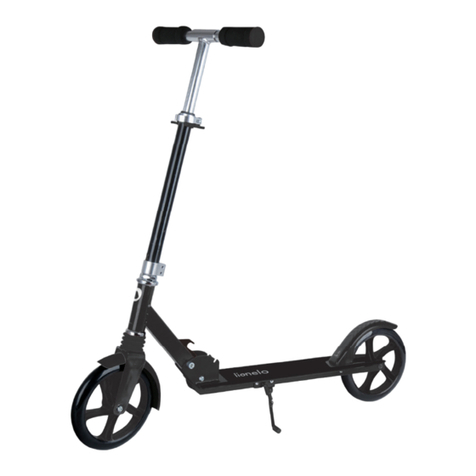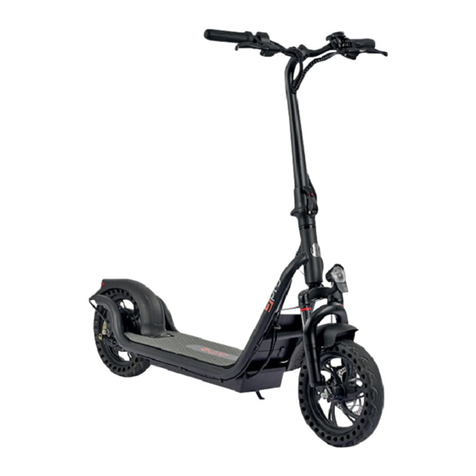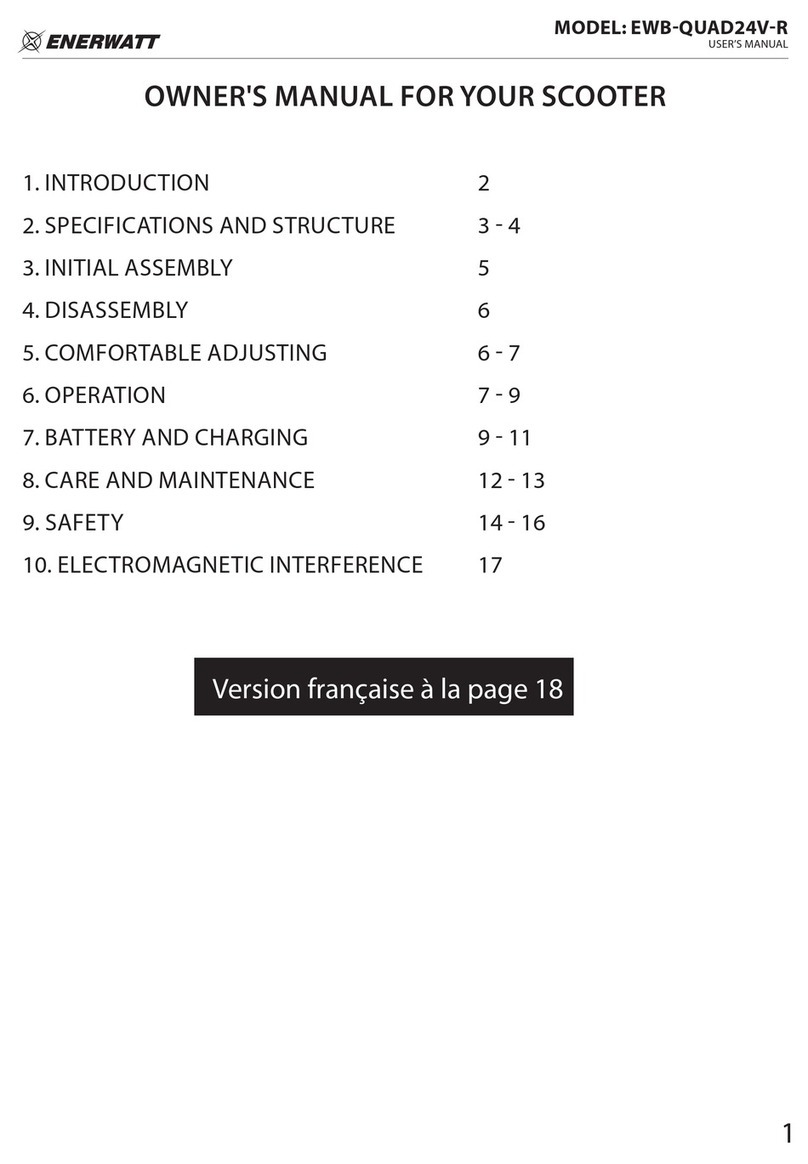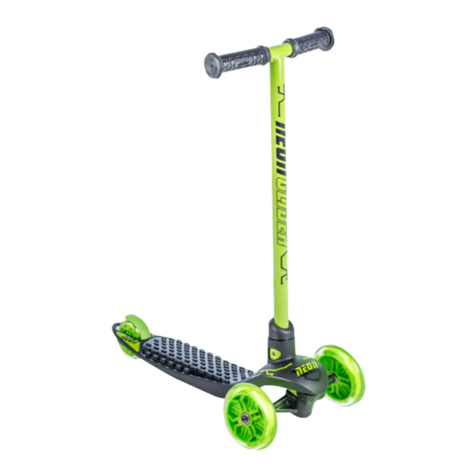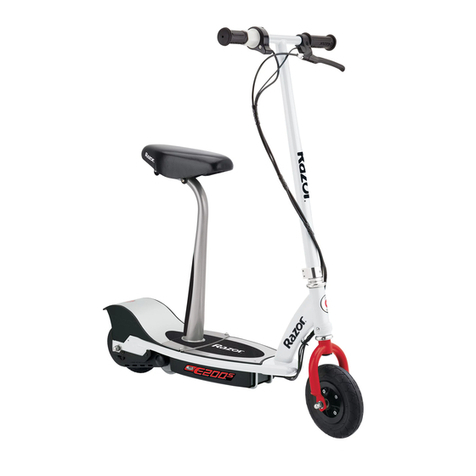TGA sonet Quick start guide

Operating Instructions and Owner’s Handbook

2
CONTENTS
1. INTRODUCTION ................................................................................................3
2. THE CONTROLS AND INSTRUMENT PANEL..........................................................4
3. SEAT ADJUSTMENT..........................................................................................5
4. DRIVING..........................................................................................................6
5. ASSEMBLY......................................................................................................7
6. DISMANTLING..................................................................................................8
7. PARKING BRAKE RELEASE...............................................................................8
8. SAFETY OVERLOAD SWITCH.............................................................................8
9. TIPS,CAUTIONS,PROBLEMS &ADDITIONAL FEATURES .....................................9
10. BATTERY CHARGING......................................................................................9
11. AGUIDE TO SAFE &LASTING BATTERIES .....................................................10
12. MAINTENANCE.............................................................................................10
13. TROUBLE SHOOTING....................................................................................11
14. TECHNICAL SPECIFICATION ..........................................................................12
15. WARRANTY .................................................................................................12
16.SAFE DRIVING TIPS FOR SCOOTER USERS.......................................................13

3
1. Introduction
The Sonet –Outdoor Powered Scooter: Thank you for purchasing from TGA. We hope your Sonet will
bring much freedom and pleasure to your life.
This handbook provides important information on the most common operational and maintenance concerns that
the user should be familiar with. It is very important that the user is familiar with the driving technique and is able
to operate the controls competently before venturing far from where there is assistance.
The handbook will draw your attention to important safety related issues by Care! Warning Labelling. Keep this
handbook for future referral –please read it thoroughly before using your Sonet.
Care! Warning
Do not ride your Sonet without fully reading this instruction manual first.
Do not exceed the maximum gradient/slope of 12%.
Do not carry passengers or exceed the maximum carrying weight (see Technical Specifications).
Do not get on or off your Sonet unless it is switched off.
Do not switch your Sonet on with the forward/reverse lever depressed.
Do not back your Sonet into uneven inclines or surfaces. Be cautious when traversing slopes.
Do not drive your Sonet in a confined space unless the speed adjustment is set to low.
Do not turn suddenly at full speed, especially on uneven or hilly ground. Failure to observe this may result in
tipping of the scooter.
Do not drive your Sonet unless the seat is locked into the driving position.
Do not drive your Sonet over deep, soft terrain (e.g. soft dirt, deep grass, loose gravel).
Do not operate your scooter when under the influence of alcohol or certain drugs, which may impair your
safety.
Do not climb or descend curbs that exceed the Sonet’s capability.
Do not turn when negotiating curbs. Always approach curbs at low speed and straight.
Always stop fully before changing direction (forward or reverse).
Always keep your feet on the vehicle when driving.
Always proceed carefully while riding your scooter, especially as you approach the downgrade of a ramp or
hill.
Always proceed carefully while riding on uneven surfaces.
Do not sit on your Sonet while being transported in a moving vehicle. Always restrain the scooter so that it
cannot move in the vehicle and transfer yourself to a vehicle seat.
Do not drive your Sonet through deep water or clean with a high pressure hose.
Never attempt to freewheel down a slope as all braking will be lost.
A seat belt is provided for your safety and it is advisable to use it at all times.
Intended Purpose
The Sonet is intended for outdoor use on gradients up to 12%. It is suitable to be used over uneven ground and
will negotiate obstacles up to 80mm high but care must be taken when negotiating such conditions. It is
unsuitable to traverse surfaces that have rutted (grooves) wider than 175mm.
Pavement Use
The speed of the Sonet is dependant on the weight of the occupant, incline and the type of surface. Tested with
a weight of 18 stone (114.55kg) the Sonet had a speed of 5.5/6 mph on the flat, on high speed setting. When
used on the pavement, the UK law limits the speed to 4mph. For pavement use make sure low speed is
selected.
Prepare the Sonet for First Use
If you receive your Sonet packaged and it has to be assembled see the section covering Assembly. The
batteries will require charging - refer to Charging the Sonet for details.

4
Care! Warning
The Sonet is easy to drive but it is essential that you familiarise yourself with the controls and learn to drive it in a
safe area with sufficient room to manoeuvre for your safety and that of others. The area should be free of
obstacles and reasonably flat. Mark a practice course for straight line driving, turning in confined spaces,
reversing and driving around obstacles.
2. The Controls and Instrument Panel
Fig 1
Figs 1 & 2 provide details of the control system. Listed below are the various controls and their uses:
Speed Control Levers -Left hand and right hand. The speed and direction can be progressively
controlled with either hand. The RH lever requires pushing forward for forward speed and backward for
reverse speed. The left hand lever the opposite, ie push forward for reverse and backwards to go forward
(fig 2.1). Push or pull the lever gently as the more you move the lever, the quicker you will go.
Emergency Brake -All braking on the Sonet is automatic and the emergency brake should never need to
be used. It is only for emergency in the very unlikely event that the automatic braking fails. If used this lever
will cut all of the power of the machine and bring you safely to a halt. Lever located on left handle bar
Horn - Press to operate (fig 1.1)
Indicators -Left and right hand. Press to switch on and press again to switch off. Indicators are
accompanied by an audible warning (1.2).
Indicator Warning Lights -Come on when using indicators (fig 1.3)
Hazard Warning Lights -Operates all indicator lights together. For emergency use only and
accompanied by audible warning (fig 1.4).
Head Light Switch -This switches on front and rear lights (fig 1.5).
Head Light Warning Light -Will come on when lights are in use. Lights will reduce range of scooter. Use
only when necessary (fig 1.6).
Ignition On/Off Switch -Insert jack plug type key and push fully home to switch on. To switch off, pull key
back until dash lights go off. Always switch off before getting off the scooter and always remove key before
leaving scooter unattended (fig 2.2). If the scooter is left switched on for a period of time and not used, it will
go into “sleep mode” and shut itself down. To re-activate for normal use, switch off ignition, leave for a few
minutes then switch on again.
Ignition On/Off Light -This will come on when the ignition is switched on with the key (fig 1.8).
7
5
2
1
2
4
7
8
9
3
6
7
3
7

5
Fig 2
Manual Speed Selection -Whilst the handlebar speed control levers (fig 2.1) progressively control the speed
for all driving, the Speed Selection facility on the control panel will set the upper speed limit. This is required by
law, as although your Sonet has a top speed of around 6mph, by law you must not exceed 4mph on footpaths
and shopping areas. In addition, this is useful when shopping and travelling through crowded areas to reduce
the upper limit even further. This also has the advantage of giving a much more gentle acceleration. (fig 1.9)
High/Low Speed Control Switch –This can be used in conjunction with the speed selection control or
separately. By switching from 1 to 0 will select high or low speed. 0 = high gear –1 = low gear (fig 2.3).
Battery Condition Indicator - Displays the state of charge of the battery. Always ensure the battery is fully
charged (green) before setting off on a journey. Amber indicates charge is getting lower and red indicates that
re-charging will be required very shortly. It is impossible to be more specific than this as different weights of
users and different types of terrain will achieve different results (fig 1.7).
3. Seat Adjustment
The seat can be swivelled fully through 360°. This allows a variety of
different positions if you need to sit at a table etc. Swivelling it within
90° allows easy entry and exit. The lever is located on the right hand
side of the seat. When the lever is released make sure the seat locks
into place (fig 3.1).
The seat adjustment lever located at the front of seat allows the seat to
be adjusted forwards or backwards (fig 3.2).
The Backrest Adjustment Lever located at the LH side of the seat allows
the backrest to be adjusted for comfort (fig 4.1).
Both armrests can be adjusted for angle by use of the lever shown at
Fig 4.2.
The headrest can be made higher simply by pulling gently upwards. To
lower there is a small lever located on the top of the seat at the base of
the left hand headrest support. Simply move the lever and adjust to
preferred height (fig 4.3).
The Seat Height is adjustable, see “Assembly” for details.
1
2
1
7
2
7
3
7
1
7
Fig 3

6
The Tiller Lever allows the Tiller to be moved to a comfortable position for driving. Press the lever, set the
tiller to your preferred position and release lever. Make sure the tiller locks into position (fig 5.1).
Fig 4 Fig 5
4. Driving
Before driving make sure that the Battery is fully charged, check that the tyres do not appear to be soft, see
Maintenance section for details of monthly checks and tyre pressures. Check that the Key is switched OFF
before entry. When comfortably sat, ensure that the seat lever has locked the seat secure. Ensure that the
armrests are in the down position.
1. Set the Sonet speed to slow. Hold the Tiller with both hands and gently push the right control lever to move
the Sonet forward. The more you push the lever, the faster you will go. Always come to a stop before
changing H or L speeds, or forward and reverse.
2. Releasing the control levers automatically operates the brakes to slow down and stop. Once stopped, the
parking brake will automatically come on.
3. Use the Tiller to steer.
4. Adjust speed to the ideal safety range by the press button control and speed control knob.
5. To go backwards, push the left control lever. The speed in reverse is reduced automatically for safety.
6. To negotiate from pavement to road, or road to pavement, you should try to find a suitable slope. The Sonet
will mount, or go down kerbs 80mm high, but you should approach a kerb at right angles (900) (so that both
front wheels mount, or dismount at the same time). You should stop just short of the edge and:
If you are going up; select a high speed setting then drive until both front and back wheels are on the
pavement, then immediately lower the speed.
If going down, proceed slowly on low setting until on the road, then switch to a suitable higher speed to
cross the road safely.
7. The Sonet is suitable for road use BUT great care must be taken and at the maximum speed of 6 mph, you
may present a hazard to other faster moving road users.
8. Watch your Battery Indicator. The distance you can travel depends on many factors, the more slopes, the
less distance you can travel. We recommend that you gradually explore going further each day.
9. Should the battery “run out” before you get home there are two things you can do to avoid being stranded.
Stopping and switching off the KEY for 5 –10 minutes will allow the battery to “recover” a little power so that
you can proceed further. You can attempt this a number of times. If you are unfortunate and cannot return to
home under the battery power there is a “Free Wheel” device that will allow someone to push the Sonet and
you home (see Parking Brake Release).
1
2
3
1
2

7
10. Range is influenced by many environmental conditions, hills will substantially decrease the range. Establish
what you can obtain around your locality by gradually increasing the distance and checking the battery indicator
at the end of each journey.
11. Reducing the speed will also reduce the power. For climbing obstacles or hills you will need to increase the
speed setting to give the power and then control the speed with the forward reverse levers.
Parking
1. Before leaving the scooter, switch the ignition off, the battery indicator will then go off. Remove the ON/OFF
Key for security.
2. If the Sonet has been used in the Free Wheel mode (see Parking Brake Release), it is VERY IMPORTANT to
re-engage the drive to ensure that the scooter brake is on before you alight.
3. Flip up the armrest to make it easier to alight from the Sonet, or swivel the seat through 900.
5. Assembly (Where Necessary)
The Sonet was pre-delivery inspected and tested prior to despatch. The batteries may have been disconnected
for delivery purposes only.
Remove all the items from the carton and strip the protective packaging materials off each item. Returns are
only accepted when the product is shipped in the original cartons with the original packing material installed.
5.1. Tiller adjustment
Press down the tiller lever and pull tiller up to preferred position. Release lever and ensure tiller has locked.
5.2. Remove Seat
To remove the seat,lower the back of the seat down and pull seat straight up and out.
5.3. Rear Cover Removal
The cover is held in place by 2 spring clips locating onto 2 tubes (fig 7.1). To remove hold the cover at the wheel
arches and pull straight up. Disconnect the rear light cable connectors before fully removing the cover (Fig 6).
Fig 6 Fig 7
5.4. Battery Connection
The batteries are already fitted to the Sonet and held by a Velcro strap. For safety reasons in transit they may
have been disconnected. Push the corresponding connectors firmly together on each battery.. They can only
be connected on way (Fig. 7).
5.5. Fitting the Rear Cover
1

8
The rear lights have to be connected before fully fitting the cover. One connector is white and one black. Take
care to fit the correct way and not trap cables when fitting cover. Locate hole in cover over seat mechanism and
tabs on front of cover into slots on footplate and push down to engage clips (Fig 6).
5.6. Attaching the Seat
Place the seat assembly over the seat pillar and push down. Partly
swivel the seat to check that the seat lock has engaged. Operate the
seat lock lever by pushing down and swivel the seat through 900,
release the seat locking handle and check that the seat locks into the
new position. Repeat so that the seat faces forward in the normal
driving position (fig 8).
The seat height can be adjusted by removing the nuts and bolts
holding the top section of the seat pillar and moving the top section to
the required height and refitting the nuts and bolts.
6. Dismantling
For ease of loading and transportation, it may be easier in some cases to dismantle the Sonet.
1. Remove seat
2. Remove Rear Cover
3. Remove Batteries. Unplug connectors, undo Velcro straps and lift out batteries. Take care when
lifting batteries as they are heavy.
4. Refit rear cover.
5. Fold down tiller.
This is as far as the Sonet will dismantle.
Care! Warning
All components are heavy, seek help if you think you may injure yourself lifting this weight.
When transporting the Sonet, please remember the various components can be potentially dangerous should
they become dislodged in any emergency braking. Ensure they are all stowed securely and strapped to prevent
movement or flying objects.
7. Parking Brake Release
Should the Sonet need to be manoeuvred for any reason without using the motor, the parking brake can be
released. The brake release lever can be found at the rear right hand side of the Sonet. Simply pull up to
disengage the brake. To re-engage the brake, push the lever down as far as it will go. NB If the brake is
disengaged there will be no drive at all to the Sonet.
8. Safety Overload Switch
If the motor or electrical circuits become overloaded, steep slope or high kerb would be possible examples that
could cause this, the overload switch may activate. This will cause a complete electrical shutdown of the Sonet
and the parking brake will come on. It can be reset after a small time delay. It is located under the rear cover on
a flat plate at the front of the seat pillar. Leave for about 1 minute and simply push the button in. If the button
refuses to stay in, leave for a few minutes and try again. If it refuses to reset get in touch with your dealer.
Never attempt to hold the button in by any other means.
9. Tips, Cautions, Problems and Additional Features
Stop Problems Before they Start
Fig 8

9
If you detect an unusual vibration or noise in the operation of your Sonet, try to determine the cause. Be sure
the power is off before investigating. If you cannot discover the cause of a problem contact your Sonet dealer or
TGA for help.
Airline Checking
Sealed Lead Acid Batteries are permitted on aeroplanes. A sticker on the battery case states what they are.
Airline personnel may insist on removing the battery cover to verity its contents. It is best to check with the
airline before hand. An airline compliance certificate is available from TGA.
Storage
Avoid storing your Sonet in locations with extreme heat or cold. A cool dry location is ideal if possible. The
following steps will help keep rust and corrosion from impairing your Sonet’s function and appearance. Turn the
key to the off position. Clean all exterior surfaces, touch-up any damaged paint. Check and inflate the tyres to
35 PSI. Be sure the battery is fully charged before prolonged periods of storage and be sure to recharge every 6
weeks. Failure to comply may result in battery replacement.
Batteries
Keeping your Sonet working to its maximum potential means that it’s two batteries must be maintained with full
power. Nightly recharging, after use, will help you to give them a longer life and will ensure your Sonet is always
ready to go when you are. However, occasionally running the batteries down as far as safely possible is also a
good idea as it allows the batteries to then take a full charge.
Your Sonet is fitted with two sealed maintenance free batteries, especially designed for powered mobility. This
means that you do not have to worry about topping up the cells.
Care! Warning
Do not attempt to remove the safety valves located on top of the battery. Failure to observe this warning will
void your battery warranty.
Your Sonet batteries are maintenance free because the electrolyte is immobilised in a special form and will not
leak out, even if the batteries overturn.
10. Battery Charging
The battery charger supplied is special to your Sonet and so it may not be suitable for any other powered
mobility product. Only use the charger supplied with your Sonet as other makes of chargers may permanently
damage your batteries and would void the warranty.
To charge your batteries follow these simple steps.
1. Switch OFF your Sonet and remove the key.
2. Plug the charger lead into the socket located at the rear of the handlebar console (Fig 5.2).
3. Push the plug from the charger into a suitable wall outlet and switch on.
4. You will see 2 lights on the front of the charger.
The green light will be indicating mains on and the other one will be amber indicating that the batteries
are charging. When the amber light changes to green, the batteries are fully charged.
5. When the batteries reach their charged state, the charger will automatically stop charging. The lights
will, however, still be on but the batteries cannot overcharge.
6. Although to get out of trouble the batteries can be put on charge for a short period of time, it is always
best to go through a complete charge cycle each time. Excessive short period charging will be
detrimental to battery life.
7. For the best results and to prolong battery life, try to run the battery down by at least 50% before
recharging and in addition it is always best to go through a complete charge cycle each time.
8. Depending on the depth of the discharge, the minimum time taken to recharge serviceable batteries fully
will vary up to 12 hours. Please note that this time may increase as batteries get older. During periods
without use (perhaps during the winter) it is wise to charge the batteries every 4 to 6 weeks.

10
9. For the best results your batteries really need to be cycled for their first 10-15 charges. This means run
them down as much as you safely can in use and then give them a full charge. They will not work at
their best until this process has been carried out.
You will find that the distance that your Sonet can travel will gradually increase over the first few weeks of
use as the batteries reach their optimum efficiency after approximately 12 cycles of discharge and recharge.
Care! Warning
Do not smoke or use a naked flame while your batteries are being charged.
Do not use the charger if it has received a sharp blow, been dropped or otherwise misused in any way. Take
it to a qualified technician.
Do not dismantle the charger. This will void the warranty.
Do not leave charger plugged into your Sonet with charger switch off as this may discharge your batteries.
For a complete charge –Do not switch off, unplug or interrupt the recharge cycle until the charging cycle has
completed.
11. A Guide to Safe and Lasting Batteries
For longest life, your batteries should be recharged after reasonable use.
If your Sonet is not used for a period of time, a refresher charge should be given every 4-6 weeks. Never
leave your batteries in a discharged condition. This is particularity important to sealed batteries such as the
type in your Sonet.
If your Sonet is to be stored away for some time, make sure the batteries are fully charged before storing.
Fully charge the batteries before re-using it.
Every six months, check the connections on the batteries, making sure they are tight and clean.
Batteries carry a limited warranty from the original manufacturer, which is subject to a stringent
wear and tear clause. Any battery faults due to a defect by the original manufacturer will normally
become obvious within the first two months. Any gradual deterioration in performance after this
period is normally associated with fair wear and tear; misuse or accidental damage is not covered by
the manufacturer’s warranty.
12. Maintenance
We recommend that the Sonet has an annual service and maintenance check by your Sonet Dealer or TGA Ltd.
The following are weekly/monthly checks that will keep the machine in good running order.
• Do not apply oil or grease to any components. Sealed bearings and nylon bushes eliminate the need for
lubrication.
• Keep all components clean and dry.
• Keep tyres inflated to 35 psi. Low tyre pressure will degrade performance so check pressure frequently.
• Check tyres for wear. Replace as soon as there is any sign of excessive wear.
• The Sonet uses maintenance free batteries, they are leak-proof regardless of position. Charging the battery is
the only maintenance required (refer to charging instructions). DO NOT leave the batteries flat, charge every
4-6 weeks if the Sonet is being stored and not used.
• Check the electrical cable connectors are fully home and secure.
• Battery Replacement is dependent upon use, the batteries generally last up to 3 years. When batteries loose
power too quickly, it is likely they are due for replacement. If there is no dealer in your area, you may want to
change the batteries yourself. Order batteries direct from TGA Ltd. Installation instructions are included with
the replacement batteries. It is always best practice to replace batteries with same type as previously fitted.
• Repairs relating to electrical or mechanical components should be performed by your Sonet dealer only.
Seat Upholstery: A damp cloth and a little soap will keep your seat, and backrest looking good. Do not use
abrasive cleaners as this will damage the coating. Upholstery can be damaged by chemical cleaners. Ultra-

11
violet light can also reduce the life of the upholstery coating material. This is a normal ageing process and
cannot be guaranteed (see exclusion in the Warranty Terms section).
Bodywork: The bodywork on your Sonet can be lightly washed with clean soapy water. Car polish can be
used to keep the paint and bodywork in pristine condition. Do not use abrasive cleaners or strong
detergents as this will fade the colour.
CAUTION: Do not hose down your Sonet. Water could be forced into the electronics and cause permanent
damage.
DO NOT store your Sonet in damp conditions. This may affect the electronics if left for very long periods of
time.
Electronics: Servicing of the drive electronics and charger should only be carried out by your local TGA
service dealer. These units are sealed and should not be opened. BROKEN SEALS WILL VOID YOUR
WARRANTY.
DO NOT operate your Sonet in extreme weather conditions i.e. very heavy rain. DO NOT drive through
deep water. This could damage the main electronic controller or the electronics.
Motor Brakes: If the motor brakes are functioning correctly, you will not be able to push your machine
when it is switched off or switched on with the speed control throttle in the neutral position.
If your machine can be pushed when as described above, the motor brake(s) may be faulty. Do not use the
scooter and contact your TGA dealer.
SAFETY NOTE: For your own safety, we recommend that you check the function of your brakes prior to
every journey.
Driving Brake: When you drive your Sonet and let go of the speed control throttle, it should reduce speed
very quickly. If you notice a change in the normal driving/slowing condition and your Sonet does not slow
down quickly please do not use your machine and contact your TGA dealer.
Batteries: Keep your batteries well charged (see Battery Charging section). Keep batteries clean and in a dry
frost-proof place. Keep battery terminals tight.
IMPORTANT: It is not possible to predict the life expectancy of your batteries. This is mainly due to different
workloads a battery can be subjected to.
Some Sonet users will use their scooter every day and for long periods of time. Their batteries will receive a
near total and regular discharge and the life of their batteries will be short (12 months or less in some cases).
Other Sonet users will use their vehicles less frequently, putting their batteries through a less demanding
discharge lifestyle. These batteries will probably have a longer life (12 to 24 months or longer).
When you need to replace the batteries, always insist on the model fitted as standard equipment to your
Sonet. If In doubt, consult with your local TGA authorized dealer.
13. Trouble Shooting
1. Your Sonet will not start:
Check it has not gone into sleep mode. Switch off, leave for a few minutes and try again.
Make sure that the key switch is turned on. If it is, the battery condition gauge will be operating. If it
is showing empty –recharge batteries.
2. The battery condition gauge fails to operate when the key switch is in the on position, check the following:
Make sure the battery charger is not plugged to the wall outlet, this will prevent drive. Check brake
release is not disengaged.
Check the battery connectors, battery terminal condition.
If none of the above contact your Sonet Dealer.
3. If your Sonet does not slow down or the variable speed control does not work:
Turn off the power on key switch.
Inform your authorised TGA dealer.
4. The Sonet stops and will not restart.
Check the overload switch, which can be reset by simply push the button in (see 8. Safety Overload
Switch).

12
CAUTION: If you find for any reason your Sonet does not reduce speed when you let go of the forward-
reverse lever, use the manual brake on the handlebars. If this fails to stop you, switch your Sonet off with
the ON/OFF key. The parking brake will activate immediately and stop your Sonet. Beware the machine will
stop very suddenly so brace yourself with the handlebars and sit back on your seat.
Care! Warning This operation should only be carried out as an emergency; continual use of this procedure
will damage the drive transmission and motor brake. Consult your authorized TGA dealer before using your
scooter again
If you feel for any reason that your Scooter is not driving correctly or making unusual noise, stop using the
scooter. Be SAFE, contact your TGA dealer, he will be able to advise you.
14. Technical Specification
Dimensions
Overall Length
1320 mm
52 ins
Overall Width
585 mm
23 ins
Turning Radius
760 mm
130 ins
Ground Clearance
75 mm
3 ins
Seat Height (from foot platform) Adjustable
460 mm
18 ins
Seat Width
440 mm
17.5 ins
Backrest Height
410 mm
16 ins
Tyre Size
260 x 85 mm
10 ins x 3 ins
Tyre Pressure
35 psi
2.4 bar
Weight (Including Batteries)
89 kg
195 lbs
Battery Weight
11 kg each
24lb each
Maximum Carrying Weight
160 kg
25 stone
Maximum speed
9.6 kph
6 mph
Safe Climbing Angle
12 %
12 %
Range (affected by user/terrain/conditions)
Up to 30 km
Up to 20 miles
Other Specification:
Controller
Dynamics
Charger
115-230 volt 5 amp
Battery
2 x 12 v 36 a/h sealed lead acid
15. Warranty
This is to certify that your TGA product is warranted by TGA for a period of twelve months from the date of
purchase subject to the following conditions:
1. This warranty is extended only to the original purchaser/user of the TGA product identified by the
product serial number located on the frame. This warranty is not transferable.
2. TGA will repair or replace free of charge any part found upon inspection by an authorised
representative of TGA to be defective in material and/or workmanship.
3. If a defect or fault is discovered, the dealer from where the product was purchased should be
notified immediately.
Warranty Exclusions

13
Tyres and the rear anti-tip wheels (these are normal wear components and replacement is not
warranted)
TGA will not be responsible for defects caused by abuse in return transit, vandalism, misuse, abuse,
accident, negligence, alteration or misuse caused by non-observance of instructions set out in the
Operators Manual
This warranty does not cover commercial or rental use of the Sonet or any use other than normal.
Upholstery and seating (these are normal wear components and replacement is not warranted)
Returns are only accepted when the product is shipped in the original carton with original protective
packing materials installed.
Returned goods to be sent to TGA carriage paid. If a successful warranty claim is found TGA will
pay return carriage.
There is no other express warranty. Any and all other implied warranties are excluded.
Your rights as a consumer are not affected.
Service Information: Only genuine TGA Spares should be used.
An authorised TGA dealer will service your Sonet under the terms of the above stated warranty. Servicing
dealership personnel are trained professionals. They should be able to answer any question you may have. If
you encounter a problem that a dealer does not solve to your satisfaction, please discuss it with the dealership's
management. The Service Manager or General Manager can help. Almost all problems can be solved in this
way. If you are dissatisfied with the decision made by the dealership's management, contact:
16. SAFE DRIVING TIPS FOR SCOOTER USERS
Scooters fall into two categories, Class 2 which is essentially a 4mph pavement vehicle and can only legally be
used on the road when either crossing over or because there are no footpaths. A Class 3 vehicle is capable of 4
and up to 8 mph and provided it is fitted with front and rear lights, flashing indicators, horn and rear view mirror it
is legal for use on the road. It can also be used on the footpaths but must not exceed 4 mph. Class 2 & 3
vehicles must not be driven on Dual Carriageways, Motorways, Bus Lanes or Cycle Tracks. Your Sonet is a
class 3 vehicle capable of 4 & 6 mph.
INSURANCE - There is no legal requirement for insurance but it is a very good idea to have cover for fire and
theft, accidental and malicious damage, and also third party damages. Just phone Karen at TGA (01787
882244) and she will talk you through it.
BREAKDOWN & GET YOU HOME SERVICE -Again a very good idea and can take a load of worry off your
mind. Just talk to Karen.
MOBILE PHONE -An essential item if you are out there alone. You never know, breakdown, accident, health -
communication is a must.
CARRYING LOADS
Do not overload. It may make the vehicle unstable and reduce its range. Place heavy loads inboard –in the
middle –not behind the back wheel which can lighten the steering or can cause the front end to lift off the road
on a bump, and not at the front which might make steering heavy.
WATCH YOUR BRAKES
Never try to drive, or even sit on your vehicle while it is in “free wheel”. The electronic brake will be out of action
and the vehicle could run away with you.
MAINTENANCE
Do carry out the checks listed in this manual regularly and also have the machine serviced at least once a year.
TYRES
Keep tyres at the pressure recommended by the manufacturer. They will last longer and be safer. Replace
when they become worn.
LIGHTS

14
Check bulbs regularly and replace when needed, use your lights frequently, at dusk onwards, on a dull or rainy
day. However, remember the use of lights may reduce the range of your scooter.
SENSIBLE GUIDELINES FOR SAFETY
When using the footpath –Just because you are on the footpath or pedestrian precinct does not make you a
pedestrian. If you are on a motorized vehicle you are no longer a pedestrian. So take care.
Remember pedestrians always have right of way! - Many people on foot will be kind and helpful to the drivers
of a wheelchair or scooter, but not everyone!
In a crowded precinct, market area, or footpath - It is your responsibility to ensure you do not run into anyone
or do any harm with your vehicle. While many people will make way for you, you cannot expect everyone to do
so. Some will appear to not even realize you are there. They will climb round and even over your vehicle rather
than allow you room to move. Also be very aware of people’s feet.
When climbing or descending kerbs –Always approach at right angles, with your front wheels straight on to
the kerb. Do not climb or descend kerbs higher than the manufacturer recommends. Move carefully, to avoid
traumatic bumps –to yourself or the vehicle.
Watch out for:
Children –They may well run in front of you without warning. You may only be moving very slowly, but
you could still injure a child.
Elderly People –They may be unable to quickly move aside to let you pass. Give way to them
Disabled people on foot –they too may be unable to dodge you
People with visual problems or impaired hearing –Give them space and time
Other motorised vehicle users –You may be doing all the right things. This does not guarantee they will
do likewise
When you need help:
You may need to ask people to open doors for you. Most people are willing to help, if asked politely. Don’t
struggle to do the impossible, or even the very difficult things when there are people around who would help if
asked.
Driving inside shops and buildings –This is where you have the advantage over car users! Not many
supermarkets would welcome a car driving round their store. But most bigger shops and even some quite small
ones, are accessible to wheelchairs and scooters. Once inside the store it is your responsibility to drive slowly
and safely and not damage the fittings or the stock, or hurt other shoppers or store workers. You may need to
ask for help. Again in most cases people are willing if asked properly. Don’t risk pulling down a whole display to
reach the top shelf. ASK FOR HELP.
Speed in shops and buildings –Reduce it! –It is a good idea to set the speed control to a lower level to avoid
any accident. Be especially careful if you need to reverse, that your way is clear of shop fittings and people.
Three wheeled scooters with their maneuverability and lightness of steering are more suited to shopping.
On the Road –Remember you are not driving a car, but a very small and slow vehicle, which is therefore more
vulnerable.
If it is possible, use the footpath. It is wise to avoid using roads, particularly busy ones.
WHEN DRIVING YOUR VEHICLE ON THE ROAD:

15
Remember although this is legal for all Class 3 vehicles it is not always safe or sensible to do so. You are
responsible for your own safety and that of other road users. The normal rules of the road apply and you must
observe the law about:
Driving on the left side of the road. Never drive against the traffic.
One way streets –Never drive against the traffic
Giving way where cars would give way (details in the Highway Code)
Obeying traffic lights and all other road signals and instructions
Giving way to pedestrians on crossings.
But always remember your vehicle is not a car and is small and vulnerable –If you need to turn right across
traffic, try to get on to the footpath before the turn and then use a safe pedestrian crossing or traffic light control
crossing. Only try to turn right if you are completely sure it is safe to do so. Do not rely only on your mirror. It
may give a false impression of distance. Always give clear indication of intention to turn left or right.
Remember –the car you can see when you look behind may appear a long way away, but it is almost certainly
moving faster than you are, often deceptively so. It could well be upon you before you complete your maneuver.
And it may not be able to stop in time.
When passing a parked vehicle –take great care you are not moving into the path of a faster moving vehicle
coming behind you, or towards you. Always signal your intention to pull out.
In the event of a difficult or dangerous situation –Use your hazard lights –But do not drive with them on
unnecessarily

16
TGA Customer Service.
TGA Electric Leisure Ltd, Woodhall Business Park, Sudbury, Suffolk, CO10 1WH
Tel: 01787 882244 Fax: 01787 882248 E-mail: sales@tga-electric.com
TGA Electric Leisure Ltd reserves the right to change specification and/or prices without prior notification or waning.
Sonet Handbook 01/04/2010
Table of contents
Other TGA Scooter manuals

TGA
TGA Breeze Midi 3 Quick start guide
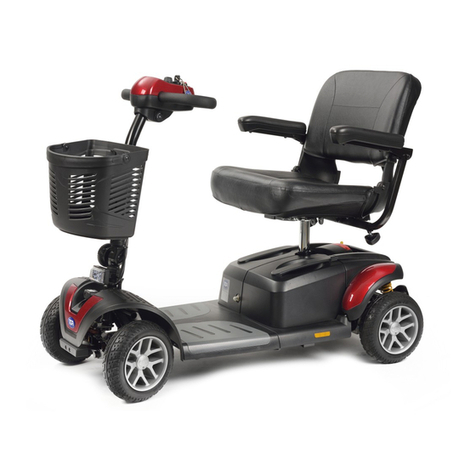
TGA
TGA Zest Quick start guide
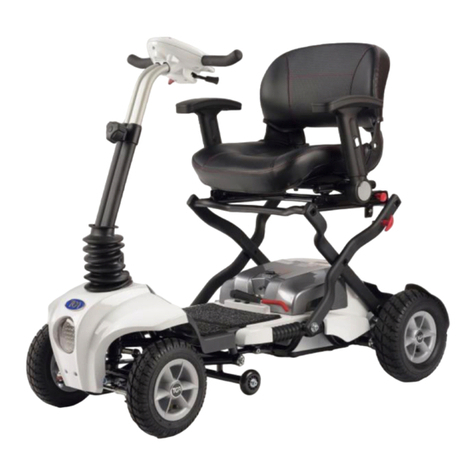
TGA
TGA MAXIMO Quick start guide
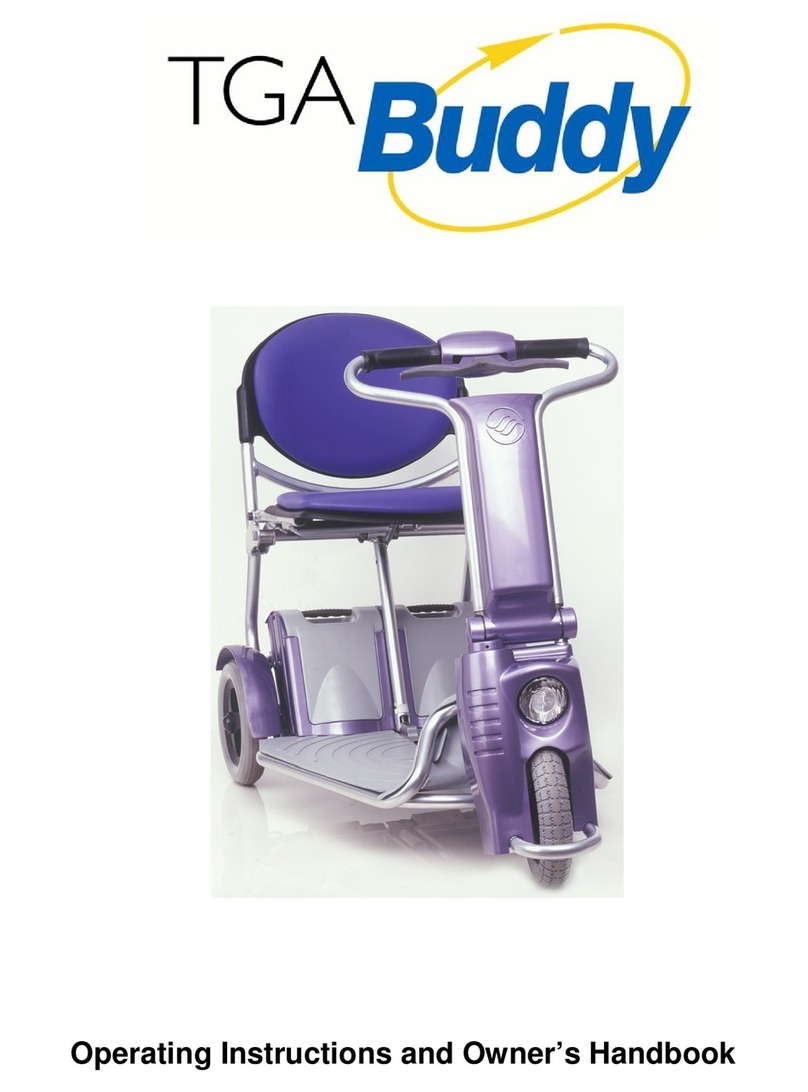
TGA
TGA Buddy Quick start guide

TGA
TGA Supersport SE Quick start guide

TGA
TGA Vita Quick start guide

TGA
TGA Breeze3 Quick start guide
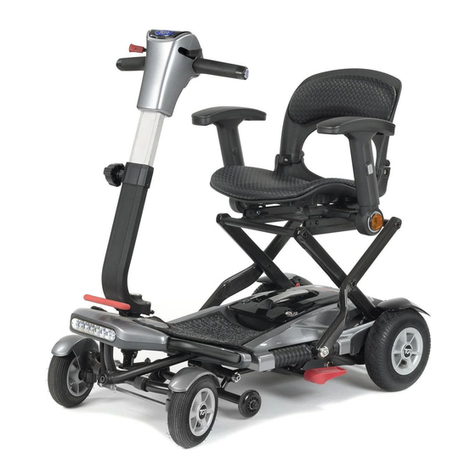
TGA
TGA Minimo Autofold Quick start guide
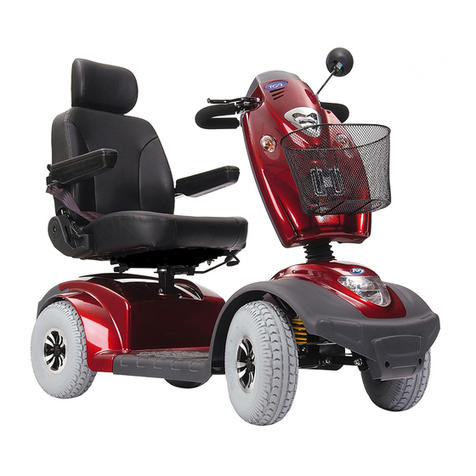
TGA
TGA Mystere Quick start guide

TGA
TGA Eclipse Quick start guide

